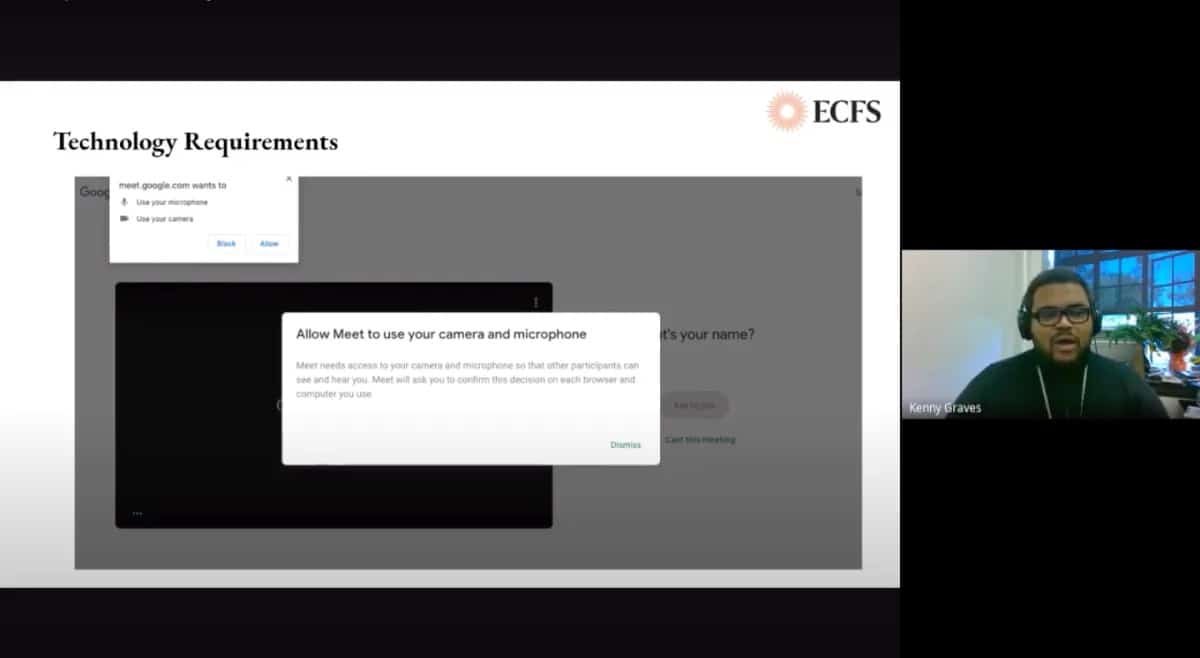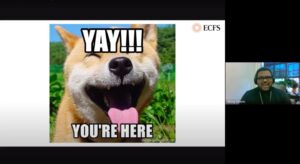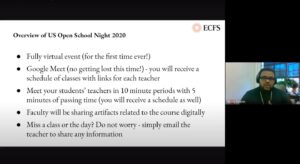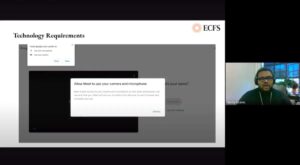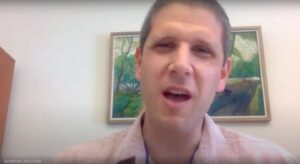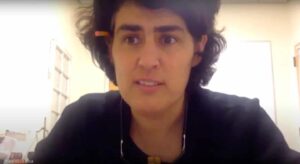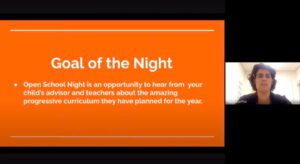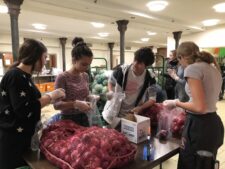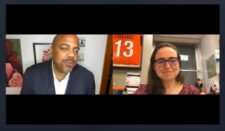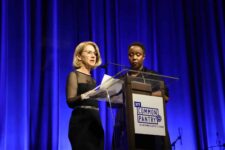When Dr. Kenny Graves stepped into his new role as Fieldston Upper Assistant Principal for Academic Life in July, a monumental task loomed before him: how to make Open School Night virtual.
“It was nerve-wracking, in terms of the technology,” Graves laughs.
In the best of times, organizing Open School Night is nothing short of daunting. Every year, each of the Ethical Culture Fieldston School’s four divisions hosts an evening program that brings hundreds of families on campus to meet with teachers; connect with other families in the same grade, class, or advisory; and glimpse a bit of the magic that goes on inside the classroom. The ongoing COVID-19 pandemic added yet another layer of complexity: Not only would Open School Night need to accommodate just as many people as before, but — with physical distancing measures precluding on-site visits — the entire experience also had to be conducted online.
It was a logistical conundrum that would have made the most seasoned of event organizers fret — but, thanks to extensive collaboration between the School’s administrative, technology, and teaching teams, this year’s Open School Nights turned out to be some of the best yet.
At Fieldston Upper, figuring out how to shepherd some 600 families — each following their student’s individual school schedule — through a rapid succession of 10-minute classes was the immediate challenge. Fortunately, Graves, who previously served as the Ethics and Technology Coordinator at Fieldston Upper, was particularly well-qualified for the job at hand.
“We wanted to replicate that experience of having parents go to faculty classrooms and what it would be like: meeting teachers for the first time, hearing about what they will be doing in the classes,” he says. In order to do that, each faculty member created their own Google Meet.
Working in tandem with Charlotte Selous, Ethics and Technology Coordinator, and Vasil Beury, Assistant Director of Technology for Data Systems, the Fieldston Upper administrative team created a massive spreadsheet tracking each student’s and each faculty member’s schedule. They used the spreadsheet to generate dozens of unique Google Meet rooms to share with faculty and families. “The biggest technological challenge was to incorporate the information collected by my teaching and Technology Department colleagues into individualized student schedules in a fairly short period of time,” Beury says, noting that the team only got one shot to get everything right.
Ensuring the event was accessible and maintaining ownership within the limitations of the Google ecosystem were also key concerns. “We pushed ourselves to think very practically about the ways different Google features would impact the lived experience of those participating in Open School Night,” Selous explains.
In lieu of darting from classroom to classroom, parents and guardians hopped from Google Meet to Google Meet to attend their student’s various classes. To help orient parents and guardians to the new virtual format, Graves also recorded and distributed a video the day before, so parents and guardians knew ahead of time what to expect.
At Fieldston Middle, Open School Night took on a similar format. As at Fieldston Upper, the administrative team collaborated with Beury and Ingrid Sabogal, Fieldston Middle Ethics and Technology Coordinator. Parents and guardians navigated their children’s schedules through a series of Google Meets, meeting teachers, advisors, and fellow parents along the way. And, like Graves, Interim Principal Jon Alschuler and Assistant Principal for Academic Life Francesca Pisa prepared an introductory video, which opened with a humorous skit demonstrating Alschuler on a “hot mic”: a gentle reminder for families to be mindful and respectful when entering the virtual spaces.
Like its Fieldston Upper counterpart, the Fieldston Middle Open School Night was a hefty undertaking for the Technology team to handle. “Part of our job is to anticipate any unintended consequences that technology may bring,” Sabogal says. “The actual technical needs were the least of our problems. It was mitigating potential roadblocks which could arise that evening that proved to be the biggest challenge by far.”
Sabogal and her colleagues need not have worried, though; the evening went spectacularly, with only two families out of hundreds facing technical issues. According to Pisa, the teachers’ experience with conducting classes through Google Meet allowed them to engage with parents and guardians in ways that demonstrated their passion for their subject and felt authentic to their teaching styles. “It didn’t feel performance-based,” she says. “It felt like it was real.”
Beyond allowing faculty to shine, the virtual format also provided a unique opportunity to innovate and improve on existing structures. At Fieldston Middle, some electives, such as those in the visual and performing arts, operate on six-week rotations. In previous years, families would only be able to attend the electives their student was currently enrolled in; this year, faculty were able to make videos to share with every family, providing a view of the full year. Looking ahead, Pisa hopes to preserve that comprehensive approach: “I think the idea that parents and guardians get to see all the arts is definitely something we’ll want to continue on into the next year.”
Bree Sheahan, a parent at both Fieldston Middle and Fieldston Upper, thought the two Open School Nights she attended were tremendous successes. “A lot of the overall format was the same, which was great in terms of being able to meet each teacher individually,” Sheahan says. Some teachers chose to stay on campus to present their Google Meets, allowing them to demonstrate how they were utilizing classroom space. Sheahan was particularly impressed by John Baglio, Fieldston Middle Engineering Teacher, who took families through the recently renovated Design Studios. “It’s an extraordinary space, so he walked us through how he has transformed the engineering program to meet this current situation, what can be used and what can’t be used.”
It was really great to see all the different tools that are being used to draw students out in different ways and keep it fun and interactive.
The virtual format also allowed faculty to demonstrate how they were implementing technology in progressive and innovative ways. “A concern for parents and guardians is how kids are engaging when everything is remote,” Sheahan notes. “It was really great to see all the different tools that are being used to draw students out in different ways and keep it fun and interactive.” During their classes, faculty showed off applications like Jamboard — a collaborative digital whiteboard developed by Google — and Peardeck — an add-on to Google Slides that integrates polls, multiple choice questions, and more.
In the lower schools, the virtual Open School Nights placed a particular emphasis on community-building. With many new faculty and staff coming on board to support the School’s hyflex model, an important feature of the events was the ability for families to put a face to a name.
Mara Kanner, a parent at Fieldston Lower and Fieldston Middle, was grateful for the opportunity to meet her son’s three new teachers. As Kanner points out, feeling like a member of the School is especially important for new families: “So much of what Fieldston Lower is about is being this really enriching and supportive and kind community, so I think it’s even more important for all the new families that the teachers do these nights up front.”
By placing the focus on community-building and shifting many of the finer curricular details to a separate curriculum night, the administrative team at Fieldston Lower was also able to highlight the widespread collaboration that is especially important this year. In each grade, teachers presented together as a panel, taking turns to lead the different parts of the night’s agenda and proving just how well they work together as a team. “We’re trying to have teachers collaborate to make their jobs more effective and more efficient,” explains Joe McCauley, Fieldston Lower Principal. “You can be a more effective teacher if you’re sharing.”
After the two Open School Nights that I’ve done, I find that the remote format really works.
At Ethical Culture, the chance to acquaint families with teachers was also vital. Dr. Erik Landgren, Assistant Principal for Pre-K–2nd Grade, notes that many teachers of specials subjects are working as classroom teachers this year — meaning that even longstanding ECFS families need to adjust to seeing beloved teachers in new roles.
Grace Wang, a parent at Ethical Culture, appreciated the opportunity to see how the backgrounds of her children’s teachers played off one another. The math specialist in her 2nd Grader’s class explained how numeracy is taught, for example, while an associate teacher with an interest in musical theatre took the lead on discussing social-emotional learning in 5th Grade.
“After the two Open School Nights that I’ve done, I find that the remote format really works,” Wang adds. “For me, seeing the slides on the computer and listening to the teacher talk about them and taking the notes just at my desk is more efficient than doing it in the classroom.”
If one thing was missing from Open School Night, it was the chance to interact with other families in person. But the virtual format offered a different form of socialization: parents and guardians, seeing familiar faces in their child’s class, would sometimes exchange friendly banter in the chat window, and children, who normally sit out during Open School Nights, would occasionally pop in during a call to witness what was going on.
At Fieldston Upper, the Technology team was in full force on Open School Night, ready to tackle any requests for technological assistance. But by the time the last family had signed off of Google Meet, only six tickets had come in — a testament to how smoothly the entire night ran. In fact, the evening was so successful that some parents emailed Graves to admit that they preferred the virtual format to the in-person one. In the future, Graves and his colleagues hope to combine the accessibility of a virtual Open School Night with the excitement of being on campus.
“Capturing the magic of Open School Night in a virtual environment is challenging. But that’s the moment we’re in: We came together,” Graves says. “That’s how we’re approaching remote learning now: It’s not just one singular person; it’s how we can all come together and figure this out.”
